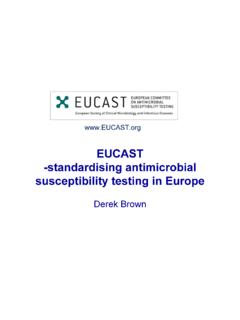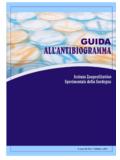Transcription of Isolation of Staphylococcus sciuri from horse skin infection
1 Open Veterinary Journal, (2016), Vol. 6(3): 242-246 ISSN: 2226-4485 (Print) Case Report ISSN: 2218-6050 (Online) DOI: _____ *Corresponding Author: Simone Bergmann. Department of infection Biology, Institute of Microbiology, Technische Universit t Braunschweig, Spielmannstr. 7, 38106 Braunschweig, Germany. Email: 242 _____ Submitted: 18/01/2016 Accepted: 07/12/2016 Published: 09/12/2016 Isolation of Staphylococcus sciuri from horse skin infection H. Beims1, A. Overmann1, M. Fulde2, M. Steinert1 and S. Bergmann1,* 1 Department of infection Biology, Institute of Microbiology, Technische Universit t Braunschweig, Spielmannstr. 7, 38106 Braunschweig, Germany 2 Center for infection Medicine, Institute of Microbiology and Epizootics, Freie Universit t Berlin, Berlin, Germany _____ Abstract Staphylococcus sciuri is known as an opportunistic pathogen colonizing domesticated animals and has also been associated with wound infections in humans.
2 Particularly over the last decade, oxacillin (methicillin) resistant strains had been emerged, which now increase the medical relevance of this species. This report describes the identification of an oxacillin-resistant S. sciuri isolate from a wound infection of a horse . We determined the absence of coagulase and hyaluronidase activity and analysed the antibiotic resistance profile. Keywords: Colonization, horse , Oxacillin resistance, Staphylococcus sciuri . _____ Introduction Staphylococcus sciuri is a member of the S. sciuri -species group composed of coagulase-negative and novobiocin-resistant bacteria (Nemeghaire et al., 2014a). This group includes S. sciuri (with three subspecies), S. lentus, S. vitulinus, S. fleurettii and S.
3 Stepanovicii (Becker et al., 2014a), which are in general considered as commensal animal-associated species (Kloos et al., 1976). S. sciuri possesses a certain pathogenic potential and is able to induce infections in both, animals (Frey et al., 2013; Dos Santos et al., 2015) and humans (Stepanovic et al., 2003). Some isolates of the S. sciuri group are known to carry different homologues of the methicillin resistance genes mecA, B and C and display methicillin/oxacillin resistance (Becker et al., 2014a,b; Harrison et al., 2014). In the present study, we report the identification of an oxacillin-resistant S. sciuri isolate from a purulent skin lesion of a horse , determined activity of coagulase and hyaluronidase and characterized the antibiotic resistance profile.
4 Case Details A Hannoveraner Hengst at the age of ten presented a purulent skin lesion on the right forehand pastern. The medical prehistory claimed repeated episodes of purulent skin infections, foremost on the bridge of the nose, which poorly healed untreated within a couple of weeks. One year later, a closed, swollen abscess-like structure was developed on the right forehand pastern. The abscess erupted within two to three days and presented a bloody skin lesion of ~4 cm in length and ~1 cm in width (Fig. 1). Fig. 1. Erupted abscess-like skin lesion of ~4 cm in length and ~1 cm in width on the right forehand pastern of the horse . The skin lesion became purulent and was treated with non-antibiotic zinc-containing ointment.
5 No systemic clinical signs were detected. Culture-based analyses/Identification of S. sciuri A swab specimen was taken from the purulent skin lesion and cultured onto Columbia blood agar plates (Becton Dickenson) containing 5% sheep blood at 37 C and 5% CO2. Morphological analyses revealed growth of uniform, non-hemolytic, white opaque colonies after 24 h at 37 C (Fig. 2A, B). Light microscopy and Gram-stain indicated a pure culture of Gram positive cocci clustered in grape-like aggregates (Fig. 2C). H. Beims et al. Open Veterinary Journal, (2016), Vol. 6(3): 242-246 _____ 243 Fig. 2. (A): Morphology of Staphylococcus sciuri on Columbia blood agar plates. (B): The zoom in indicates white to light grey staphylococcal colonies without any haemolytic activity.
6 (C): Gram-stain visualized Gram-positive, coccoid bacteria, clustered in grape-like structures. Strain identification by sequencing of 16S rRNA was conducted from a single colony as described elsewhere (Weisburg, et al., 1991) using the following oligonucleotides: forward primer: 27f 5 -AGA GTT TGA TCM TGG CTC AG-3 , reverse primer: 1492 r 5 -CGG TTA CCT TGT TAC GAC TT-3 and was repeated three times using colony material from the same culture plate. After purification of PCR-products using QIA quick PCR Purification Kit (Qiagen) sequencing procedure was performed by GATC-Biotech (Germany). Blast search (provided by NCBI, NLM, Bethesda, USA) identified S. sciuri in all three independent probes as primary infectious agent.
7 The listed blast results presented in Table 1 confirm the high sequence identity with up to 98% query coverage to S. sciuri in all of the tested three independent probes. Results further point to the identification of carnicatus or rodentium as respective subspecies but the nominal difference to the results given for the third potential subspecies sciuri were not significant enough to allow a final determination of the subspecies. A bacterial colonization analysis from swabs taken from the horse nostrils did not identified S. sciuri as constant colonizer of the horse , but identified typical members of horse microflora such as Aeromonas viridans and S. vitulinus by Maldi Tof. Verification of strain-identification and MIC-determination Species identification of the S.
8 sciuri isolate was confirmed using the standardized API STAPH system and revealed an ID value of The specification of the respective isolate was further confirmed using the bioM rieux VITEK 2 system (Germany) according to the manufacturer recommendations and also independently by the National Reference Center of Staphylococci and Enterococci of the Robert Koch Institute (RKI) in Wernigerode, Germany. Table 1. 16 SrRNA-based sequencing results from three independent culture probes as obtained by blast -sequence alignment (NCBI; NLM). sample hit S. sciuri subsp. carnicatus rodentium sciuri 1 1 Strain GTC 1227 GTC 844 ATCC 29062 Query cover 98% 98% 98% Ident 85% 85% 85% Accession NR NR 2 Strain GTC 1227 GTC 844 ATCC 29062 Query cover 98% 98% 40% Ident 85% 85% 85% Accession 3 Strain ATCC 700058 ATCC 70061 Query cover 40% 40% Ident 82% 82% Accession 2 1 Strain GTC 1227 GTC 844 ATCC 29062 Query cover 96% 96% 95% Ident 86% 86% 86% Accession 2 Strain GTC 1227 GTC 844 ATCC 29062 Query cover 96% 96% 35% Ident 86% 86% 82% Accession 3 Strain ATCC 700058 ATCC 70061 Query cover 35% 35% Ident 82% 82% Accession 3 1 Strain GTC 1227 GTC 844 ATCC 29062 Query cover 95% 95% 95% Ident 86% 86% 86% Accession NR NR 2 Strain GTC 1227 GTC 844 ATCC 29062 Query cover 95% 95% 37% Ident 86% 86% 82%
9 Accession 3 Strain ATCC 700058 ATCC 70061 Query cover 37% 37% Ident 82% 82% Accession Furthermore, automated antimicrobial susceptibility testing was performed at the National Reference Center for Staphylococci and Enterococci of the Robert Koch Institute in Wernigerode, Germany via H. Beims et al. Open Veterinary Journal, (2016), Vol. 6(3): 242-246 _____ 244 microbouillon-dilution, including the following antibiotics: -lactams (benzylpenicillin, oxacillin), macrolides (erythromcycin), lincosamides (clindamycin), oxazolidinone (linezolid), fucidanes (fusidic acid), aminoglycosides (gentamycin), ansamycins (rifampicin), tetracycline (oxytetracyclin), glycopeptides (vancomycin, teicoplanin), gylcylcyclins (tigecyclin), fluoroquinolons (ciprofloxacin, moxifloxacin), cyclic lipopeptides (daptomycin), the epoxid fosfomycin and the folate synthesis inhibitor cotrimoxazol.
10 MIC value determination was evaluated according to the EUCAST standards for human medicine and revealed sensitivity to most of the tested antibiotics (Table 2). Table 2. Analyses of MIC of different antibiotics by the National Reference Center of Staphylococci and Enterococci of the Robert Koch Institute in Wernigerode, Germany, evaluated by EUCAST-based interpretation. Antibiotics MIC ( g/ml) interpretation Benzylpenicillin S Oxacillin R Fosfomycin R Gentamycin S Linezolide S Erythromycin S Clindamycin S Oxytetracyclin S Tigecyclin S Vancomycin S Teicoplanin R Ciprofloxacin S Moxifloxacin S Daptomycin S Co-trimoxazole S Rifampicin S Fusidic acid R Interestingly, the antibiotic resistance profile covering 17 antibiotics indicated a resistance against fosfomycin, fusidic acid and teicoplanin (Table 2).







